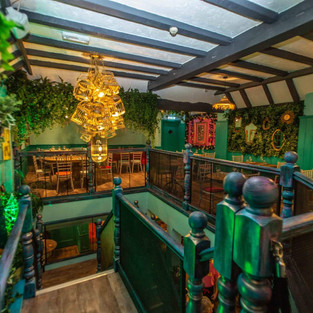EAT LOCAL
- Sarah

- Oct 16, 2020
- 3 min read
Updated: Dec 29, 2023
Chain restaurants are ubiquitous - they infest every town centre with their generic cuisine, whether its pizzas and pastas, burgers or a slightly soggy risotto. With menus the same across the country, food shipped in from a single source many miles away, themed décor and often irritating muzak, eating at chain restaurants may not be a terrible experience, but it is rarely a great one.

The world's largest restaurant, McDonalds, has nearly 40,000 restaurants across 120 countries, and they serve 69 million people a day, with the golden arches logo recognisable across the world.
It was in fact a McDonalds being built at the foot of the Spanish Steps in Rome which started the whole Slow Food Movement in 1986. 25 years later, the movement has over 150,000 members across 150 countries, with the emphasis on locally produced, good quality food.
The same applies to coffee shops such as Costa or Starbucks - they have filled high streets, petrol stations, canteens, popular beauty spots; they are everywhere.
Starbucks has over 30,000 shops in 70 countries, Costa has nearly 4,000 across 3 continents. People used to dream of running their own little coffee shop, but few bother now when the competition is this fierce. Peaceful and quirky little tea rooms are now becoming a thing of the past, instead we only get to chose between the large chains.
Reasons to avoid chain restaurants
1. The food is often sourced from a single supplier and shipped many miles across country to get to the individual restaurants, usually by polluting trucks, planes and container ships.
2. Local food producers, who don't supply in high volume and can't afford to slash their profits, get priced out of the market.
3. Local specialties are usually ignored for menus which can be used across the whole chain, meaning that not only do customers not get to try new things, but that local specialty producers get ignored.
4. Food is often heavily packed with chemicals to extend its shelf life for both transportation purposes and to cut wastage. Flavour enhancers are used to disguise the lower quality produce.
5. Food prepared in chain restaurants is often highly calorific, with large portions and increased chemicals meaning a higher level of bad food groups.
6. The prevalence of chains means that local entrepreneurs get priced out of the market, unable to afford business rental rates.
7. Food is often part-cooked at the chains supply depot, rather than in the restaurant, so you often end up eating food which was cooked months ago, frozen and then heated in a microwave just before being served to you. Nutrients are severely diminished, as is the taste.
8. The ambience of the restaurant is the same as in every other in the chain - you get the same themed décor, same muzak, same uniformed staff. It is bland, generic, uninspiring and boring.
9. Chain restaurants don't care so much about reviews, so they put less effort into customer service or good cooking.
10. Your money goes off to head office, often in a different country, and doesn't get spent in the local community.
Reasons to Eat Local
1. Locally owned restaurants can be far more selective about where their food comes from, with no compulsion to buy from a supplier many miles away. This means that you are far more likely to eat food which has no food miles on it, maintaining its nutritional qualities and meaning that the owner can shop around for the best flavours for their dishes.
2. You are far more likely to be able to try local specialties and local dishes, and the menu may well have more unusual options that you just couldn't find elsewhere.
3. The restaurant or café will be unique in its style, décor and layout.
4. Owners and staff are more likely to chat to customers, seeing the benefits of taking the time to get to know their customers and develop a rapport.
5. Menus are more likely to change on a weekly or even daily basis.
6. Staff care a lot more about reviews, as a bad review can break a small business, so you will probably get much better levels of customer service.
7. With food prepared on site, you are able to ask for alterations to a dish.
8. Smaller, locally owned restaurants are less likely to generate so much food waste as they are more conscious of their overheads.















Comments